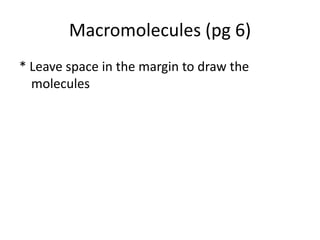
Macromolecules
- 1. Macromolecules (pg 6) * Leave space in the margin to draw the molecules
- 2. Macromolecules (pg 6) • Large molecules. Made of subunits.
- 3. 1. Carbohydrates • Subunits = Sugars
- 4. Carbohydrates • Subunits = Sugars • Contain C,H,O arranged in rings
- 5. Carbohydrates • Subunits = Sugars • Contain C,H,O arranged in rings • Examples: – Monosaccharides: Glucose, Fructose
- 6. Carbohydrates • Subunits = Sugars • Contain C,H,O arranged in rings • Examples: – Monosaccharides: Glucose, Fructose – Disaccharides: Sucrose (table sugar), Lactose
- 7. Carbohydrates • Subunits = Sugars • Contain C,H,O arranged in rings • Examples: – Monosaccharides: Glucose, Fructose – Disaccharides: Sucrose (table sugar), Lactose – Polysaccharides: Starch, Glycogen
- 8. Carbohydrates • Subunits = Sugars • Contain C,H,O arranged in rings • Examples: – Monosaccharides: Glucose, Fructose – Disaccharides: Sucrose (table sugar), Lactose – Polysaccharides: Starch, Glycogen • Functions: – Energy, food storage, cell identification
- 9. 2. Lipids • Subunits = Fatty acids
- 10. Lipids • Subunits = Fatty acids • Made almost entirely of C and H
- 11. Lipids • Subunits = Fatty acids • Made almost entirely of C and H • Long carbon chains or rings
- 12. Lipids • Subunits = Fatty acids • Made almost entirely of C and H • Long carbon chains or rings • Functions: Energy storage, insulation, cell membranes, hormone precursors
- 13. 3. Nucleic acids • Subunits = Nucleotides
- 14. Nucleic acids • Subunits = Nucleotides • Structure = Sugar + Phosphate + Base
- 15. Nucleic acids • Subunits = Nucleotides • Structure = Sugar + Phosphate + Base • Examples: DNA, RNA
- 16. Nucleic acids • Subunits = Nucleotides • Structure = Sugar + Phosphate + Base • Examples: DNA, RNA • Function: Store genetic information
- 17. 4. Proteins • Subunits = Amino acids
- 18. Proteins • Subunits = Amino acids • Contain C,H,O,N,P,S
- 19. Proteins • Subunits = Amino acids • Contain C,H,O,N,P,S • Long chains of amino acids that fold up into complex shapes
- 20. Proteins • Subunits = Amino acids • Contain C,H,O,N,P,S • Long chains of amino acids that fold up into complex shapes • Functions: – Transport (move things in and out of cells)
- 21. Proteins • Subunits = Amino acids • Contain C,H,O,N,P,S • Long chains of amino acids that fold up into complex shapes • Functions: – Transport (move things in and out of cells) – Structural (Keratin forms outer layer of skin)
- 22. Proteins • Subunits = Amino acids • Contain C,H,O,N,P,S • Long chains of amino acids that fold up into complex shapes • Functions: – Transport (move things in and out of cells) – Structural (Keratin forms outer layer of skin) – Enzymes (speed up chemical reactions)
- 24. Output (pg 7) • Write a “help wanted” ad for a macromolecule • Include: 1. A description of the job 2. The location of the job 3. The characteristics the macromolecule needs to do the job well Example: Protein Needed! We need a fast, efficient protein to transport items in and out of a liver cell. You will work in the plasma membrane. Previous experience transporting glucose molecules a plus. You must be made of amino acids, have a complicated shape, and be ready to work hard!
